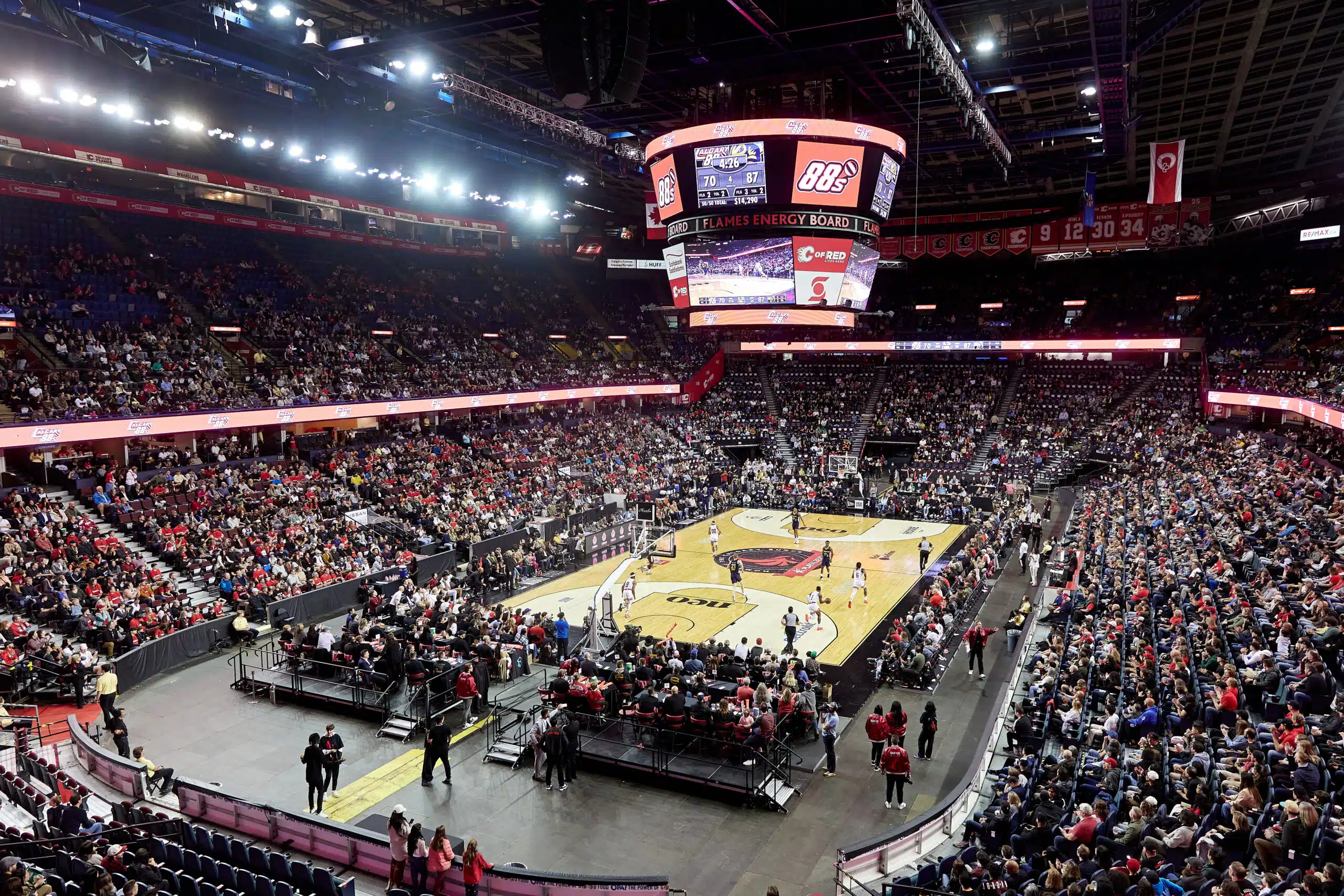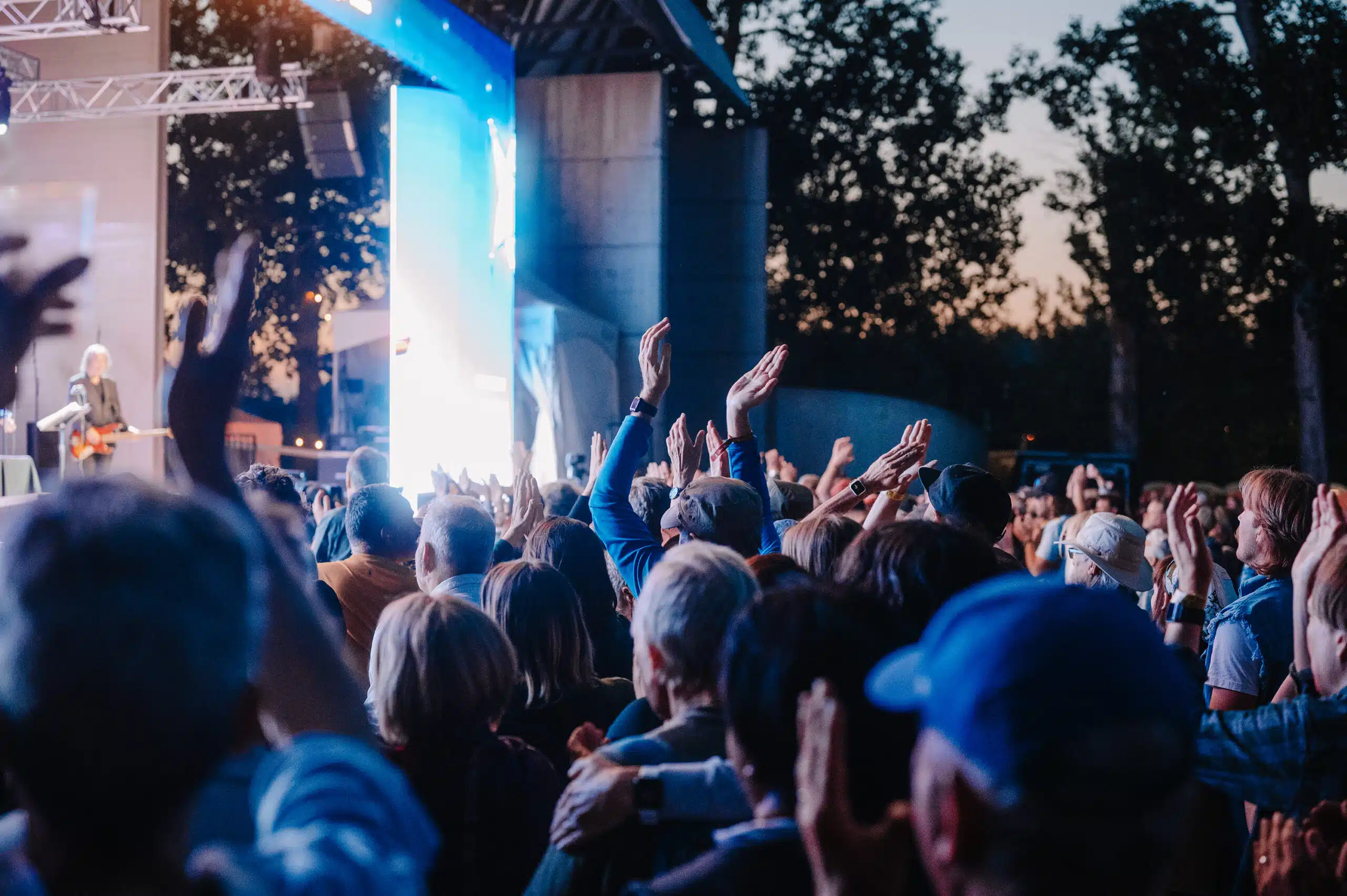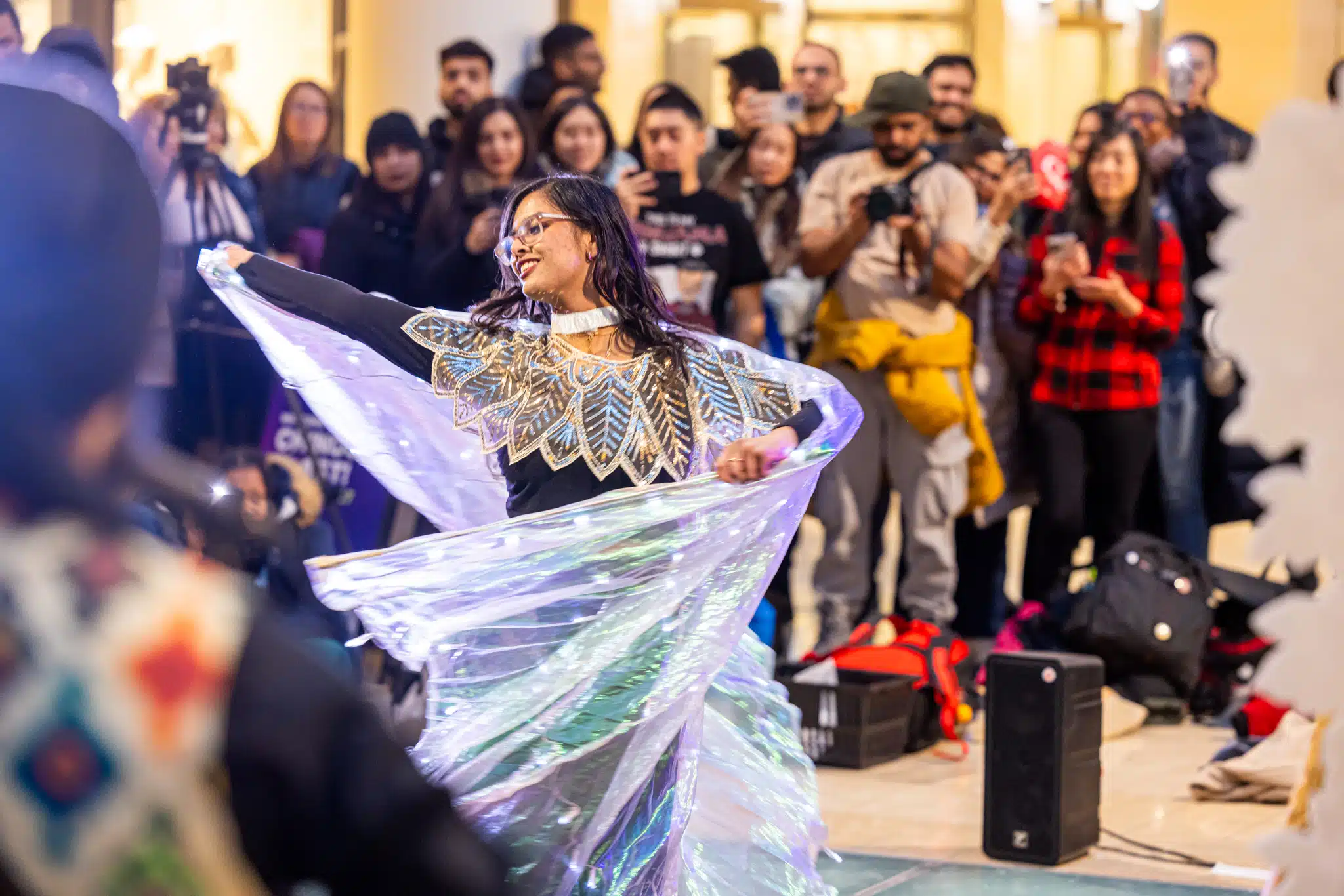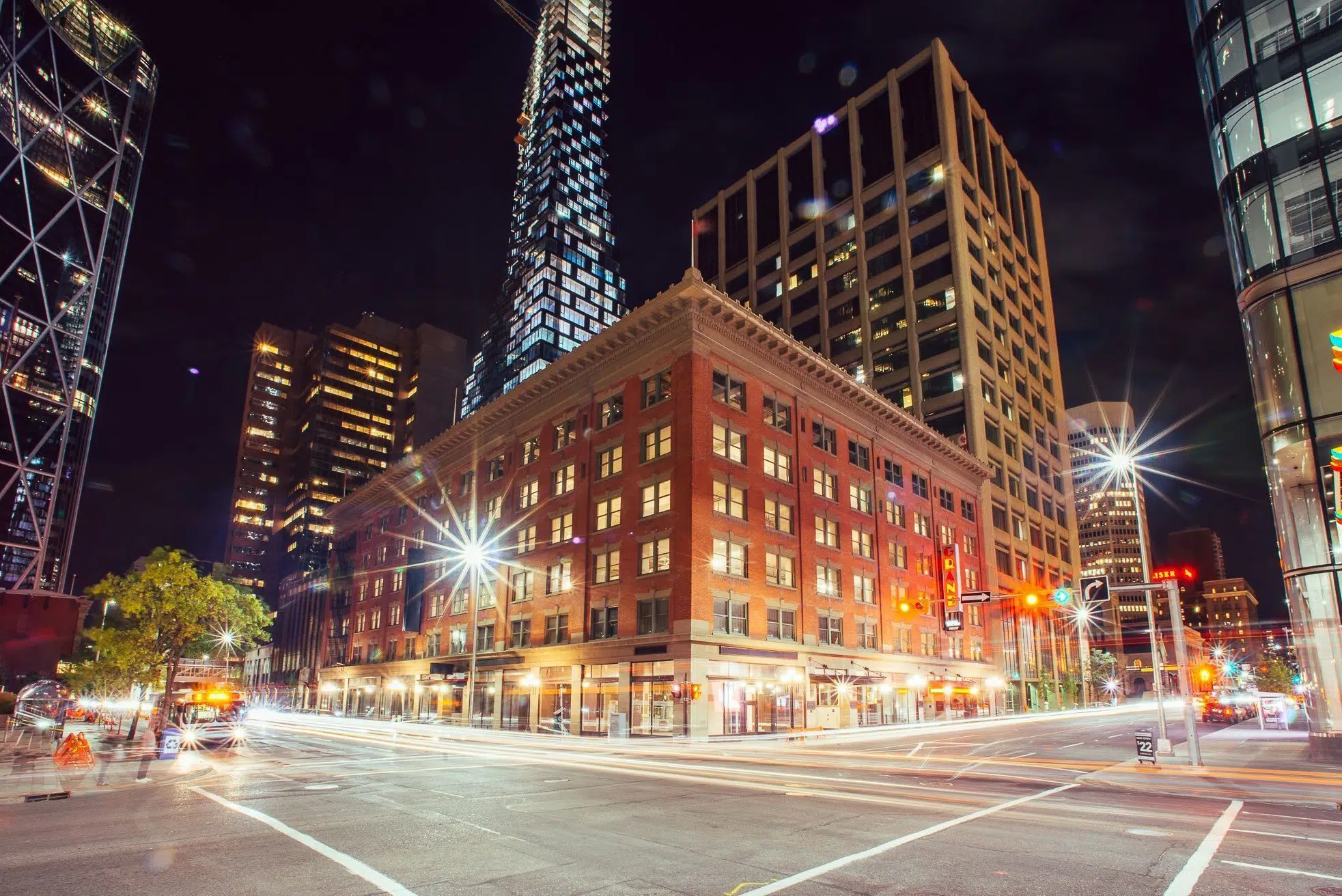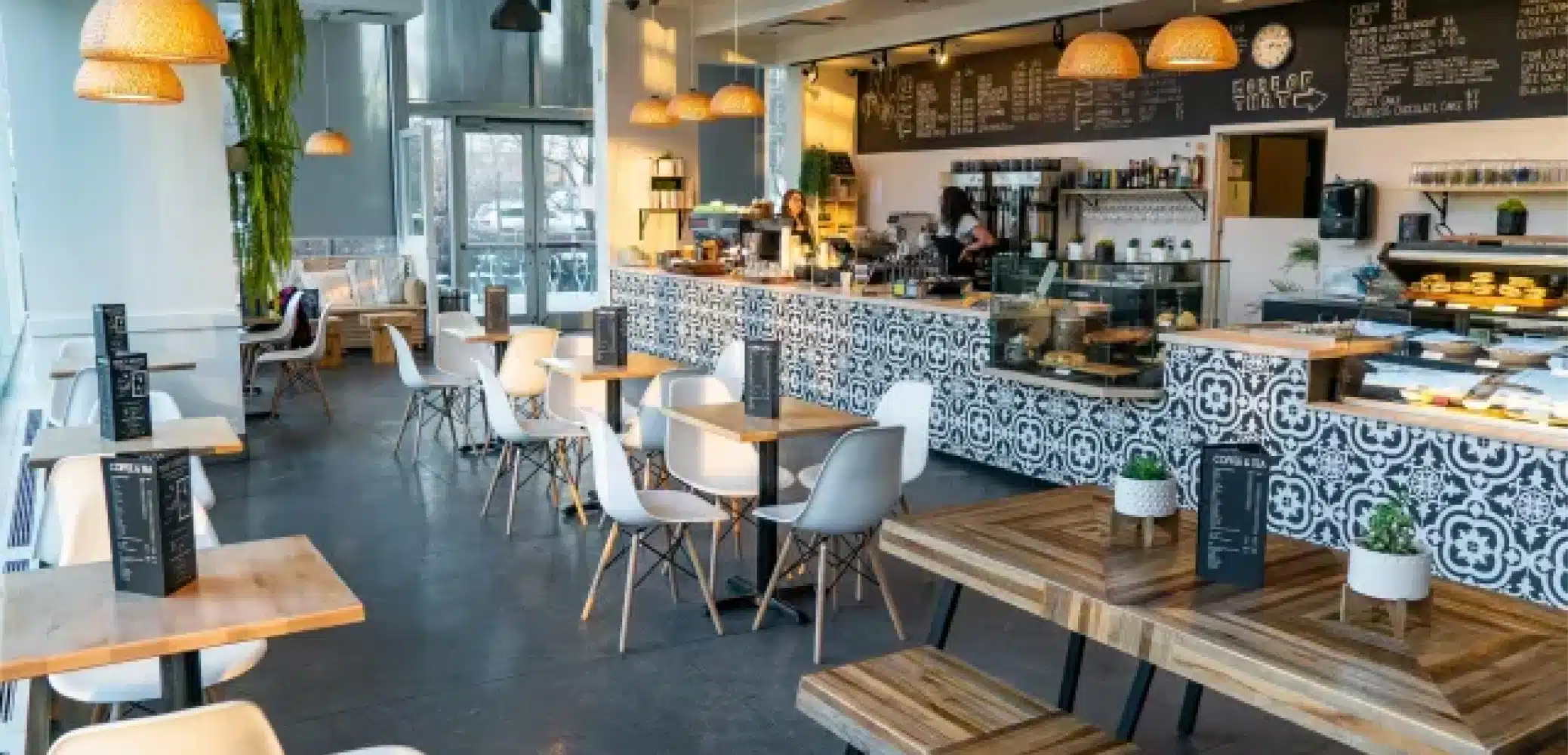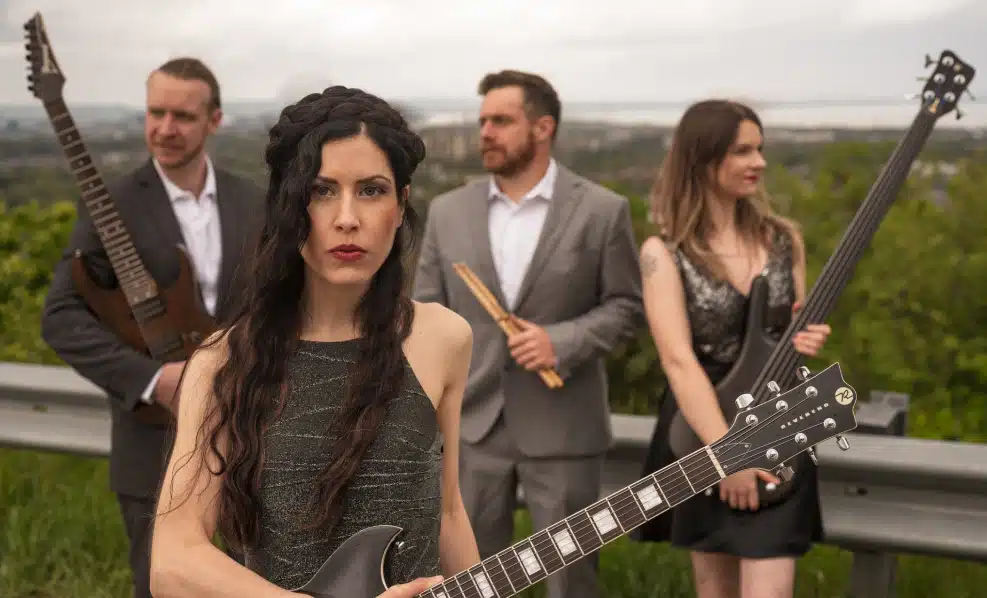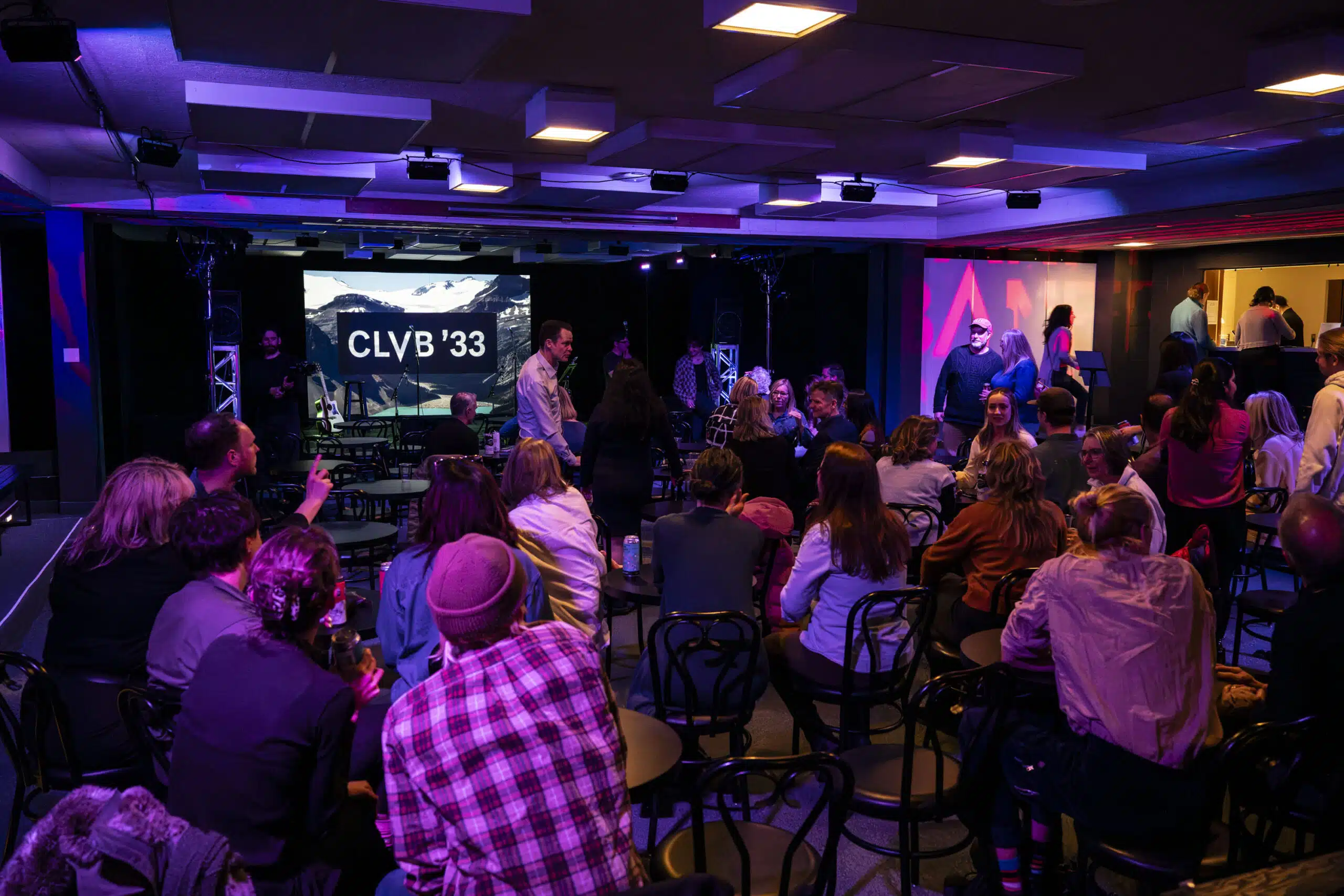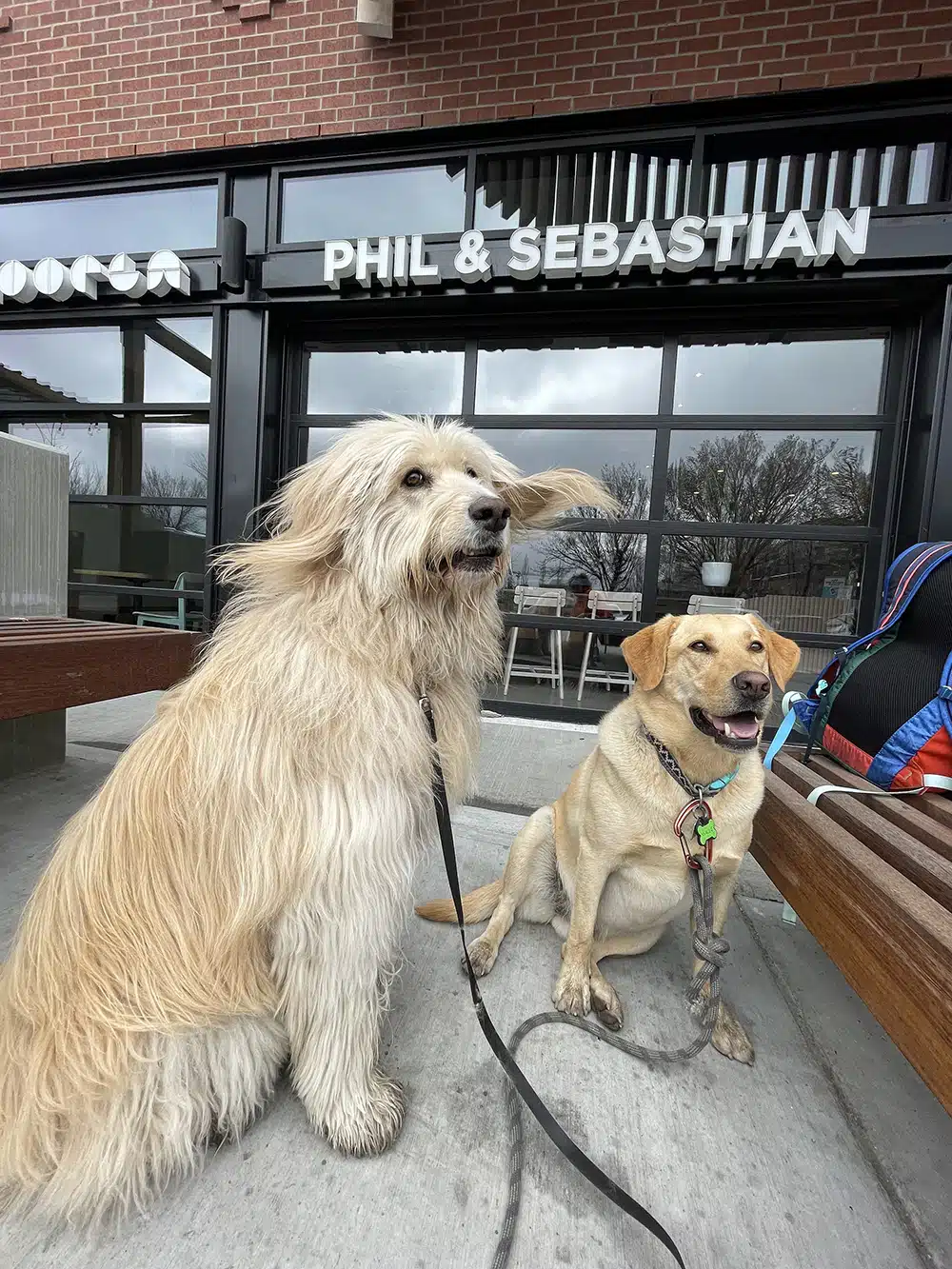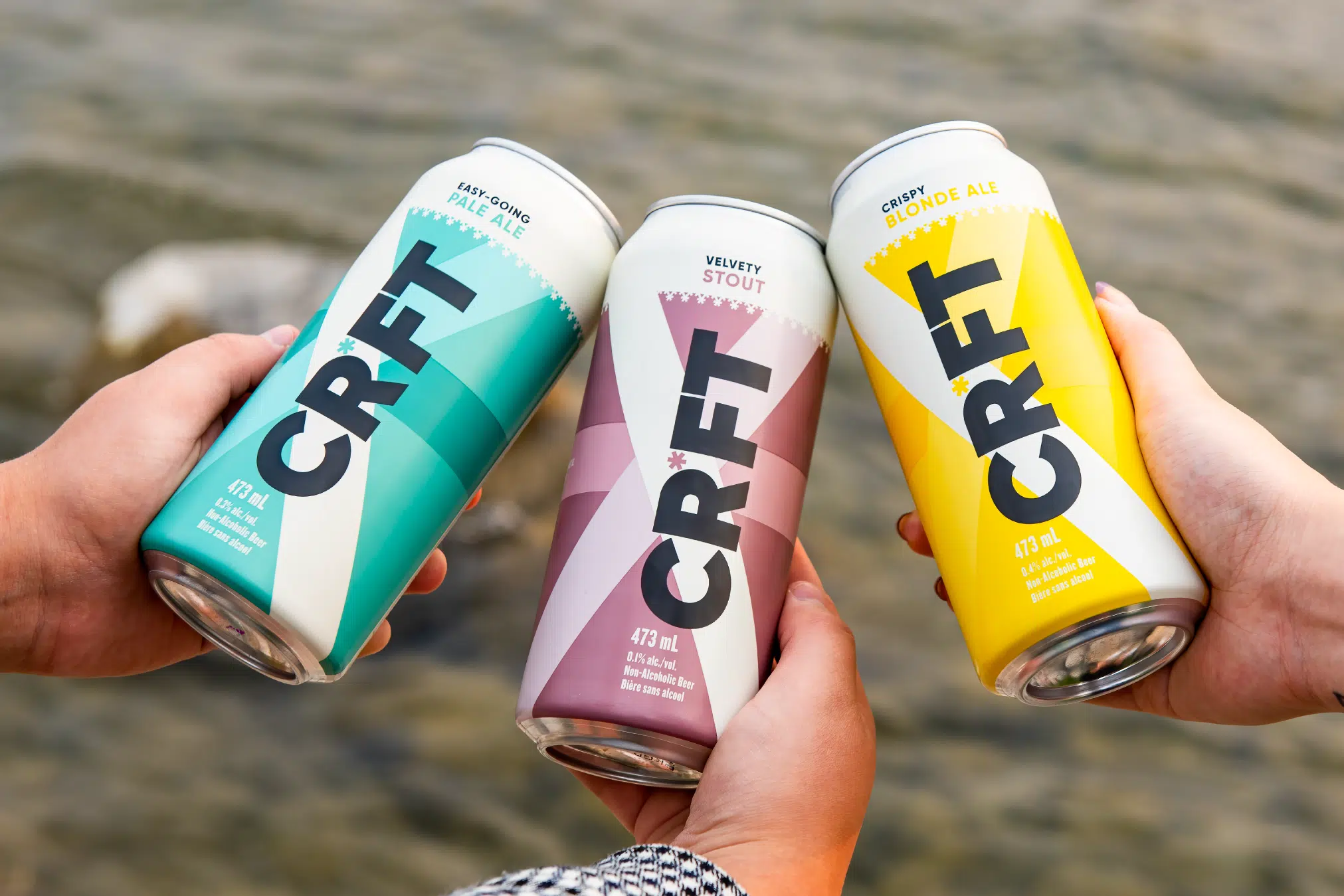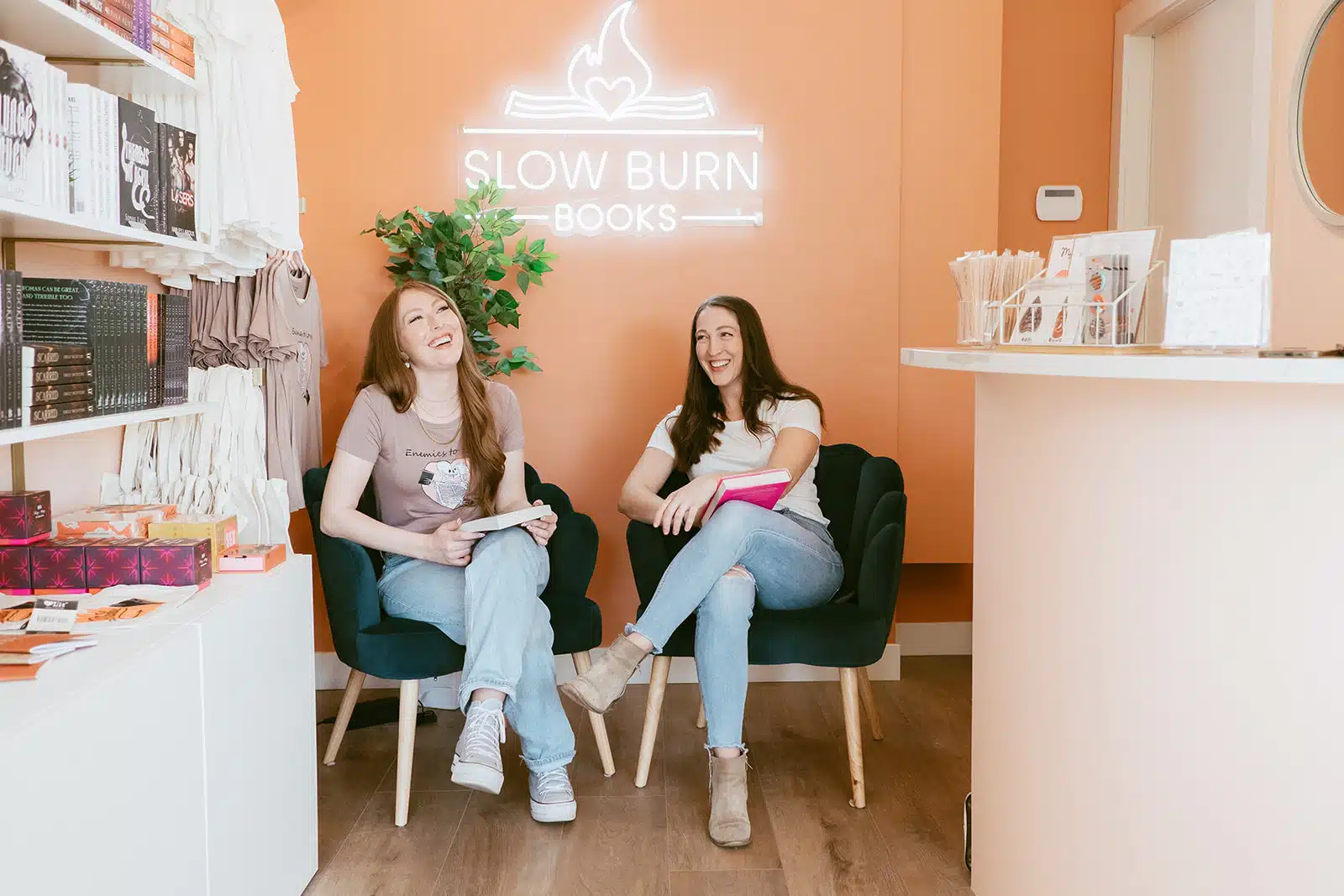Professional basketball. Professional theatre. Two seemingly different worlds that share a surprising amount of common ground.
Alberta Theatre Projects is currently exploring this idea with Rajiv Joseph’s play King James, a story about friendship, identity, and the cultural significance of basketball (onstage at the Martha Cohen until March 16).
Later this year, in May, the Calgary Surge kicks off its third year of professional basketball in Calgary, dubbed the “Trilogy” season.
The Scene brought ATP’s artistic director, Haysam Kadri and the Calgary Surge’s vice-chairman and president Jason Ribeiro together to delve into the intersection of sports and the arts in Calgary and their personal histories with the sport.
–
Haysam Kadri: “Jason, it’s obvious that you’re embedded into the community based on your participation on corporate boards and nonprofit boards. What possessed you to start Calgary’s professional basketball team?”
Jason Ribeiro: “Our desires in our professional and personal lives have always been motivated by this place. Calgary, Mohkinstsis, Treaty
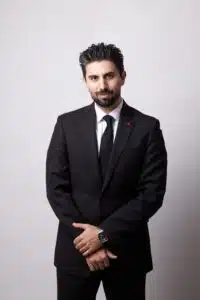
7: At various points in time, the city has needs, and the city has opportunities. What’s really great about this place is that you’re living in a community in the city where you can actually make a difference. There’s a limited barrier to entry in terms of making an impact, volunteering, and starting a company. That’s what makes this place so special.
“For us, it’s been, ‘what is Calgary missing? What does Calgary want? What does Calgary need?’ And I’ve always been fascinated by the fact that no city is perfect, right? Communities and cities have beauty marks, and they have blemishes. Any time we can address those, both in highlighting the beauty marks and telling that story — not only to ourselves but to communities abroad and around the world — and then address some of these blemish marks, it’s a great responsibility. How you can do that creatively is where the magic really comes.
“I’ve been involved in the sports community for a long time. I’m the vice-chair of Sport Calgary’s board of directors, so I’ve gotten to know the ecosystem really well. The legend goes, the Canadian Elite Basketball League announced that they were moving a team from Guelph, Ontario, to Calgary, Alberta, and that it would be operated as a league-owned team. In such a close community like Calgary, we felt that Calgarian sensibilities and stories needed to be embedded in it from the beginning, and that’s where Usman [Tahir Jutt, Surge chairman] and I have gone on this journey. And here we are, two and a half years later.
“We all have the opportunity to tell stories about our communities and tell stories about people, and those stories are instructive. Sports is such an elemental, mercurial force in our daily life, whether you’re checking stats, whether you’re putting on a jersey, whether you’re chanting the same song; the same way that the theatre can be a transformative experience. I feel like we’re comrades or co-conspirators in trying to do some of the same things, even though, on the surface, they might feel like very different entities.”
HK: “I was on the high school basketball team, and I was in the high school play as well. So you know, I felt like I was like the peacemaker between the jocks and the drama students. Sports are big in my life; it always has been big in my life… I love going to a sporting event, and going, ‘How do I capture that scene, [that] lightning-in-a-bottle when you go to a basketball game? And how do we bring that and translate that to the theatre?’ So it’s my two love languages: theatre and sports.”
JR: “You couldn’t have summed up my early life any better. It was the exact same thing. And the desire that you have to capture and bottle up the moment — when the Surge hits that target score winner, and the entire building erupts as part of the play — is the mutual envy that I have for artists and directors and performers like you and your folks. Where you’re so envious of this kind of big, bottled-up moment, I’m so enthralled by the quiet moments of the stage and the empty spaces and the pauses and the intimacy.”
“What we’ve tried to do in developing and building the Surge — there’s really no playbook. We don’t have a professional sports background between the two of us. We’ve been able to hire some amazing people that do. But it’s just like high school already, where we’re trying to pull apart those tensions and say, ‘Hey, we’re gonna shut down Contemporary Calgary for a day and film our season two teaser, where the players will be moving through that brutalist structure as though they’re the art and bringing life to that building.’ I got more than a few puzzled looks from our staff, who are through and through sports fans! … To be able to then play that teaser in black and white with harpsichord in the background, in front of 12,000 people in the Saddledome has shown us where that collaboration, where that intersection really lies for us and where we can learn from each other.
“So the envy has always been mutually appreciated. Personally, for me, for the arts community has been really long-standing, and I think we have so much to learn from each other and amplify.”
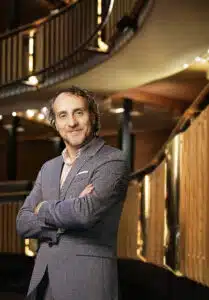
HK: “Well, listen, I’ve been to three games, and the target score concept is absolutely brilliant. You are embedded into a high-stakes world, and when you shut the clock off, it’s a huge game-changer. It’s a really exciting product.
“I’m so glad that you brought basketball back to the city. The last time I remember was [the] Calgary 88’s, and I was excited about the 88’s when they were here … Have you seen instances where basketball has brought people together in unexpected or profound ways?”
JR: “Absolutely, and I think it’s one of the unintended consequences of bringing this type of product and embedding it in the culture.
“I grew up just outside of Toronto and then moved to downtown Toronto. And [now] as a 35-year-old, the [Toronto] Raptors are just celebrating their 30th anniversary. I got to watch the birth of that franchise and be there. I remember going to those first couple of seasons and then seeing Vinsanity take over the city, the down years, and then the intersection between the city’s identity and the team’s identity and the broader cultural influence it has. So I feel like I’ve had a one-on-one in terms of basketball and community before I moved to Calgary in 2015, but the unintended consequences have been the most surprising and the most beautiful in its intersection with the arts.
“We may be one of the only sports products in Calgary — and potentially in Calgary’s history — where it matters what you wear to the game, outside of a jersey, outside of fan apparel. We’re seeing people taking out those new sneakers or curating their outfits in the same way that people in the arts community have done for concerts, plays, and performances for hundreds and hundreds of years. For us, it’s been, ‘How do we take what’s happening organically and then amplify and encourage?’ It’s not something where people are showing up and we’re judging or being label conscious about who’s wearing what: It’s [about] people fully expressing themselves in a way that they don’t often get to do, whether they be sporting events or not. I get a kick out of the fact that someone has taken time [to figure out] how they’re going to dress to come to a game, whether they’re wearing a Surge hat or jersey or not. From an inclusion and diversity perspective, being able to create that community or create that environment is really heartening.
“Then, there’s the more traditional conceptions [of having] your anthem singers, your halftime performers, having your dancers. The perspective that we’ve had is, ‘Let’s put more effort in curating those performances than typical sports teams do.’ Typically, sports teams have an anthem singer and then a backup singer when the anthem singer can’t attend. They hire their own cheerleading squad or dance crew and then, from a half-game perspective, have them as super elementals of basketball, and then maybe a little bit for football, but not really for any other sports where you’re expecting a bit of a show or programming versus just some activations. For us, it’s really about playing curator. There shouldn’t be one anthem singer; there should be 10 or 12, and [we should] give many more artists an opportunity to grace that stage. There should be many DJs in the building, outside of the building, and in the plaza. There should be 10 different halftime performances. The ability to curate and build multiple stages for multiple local artists in Calgary has been really beautiful. Some of that’s happened organically, but others have been by design. It’s more work, but I think the reward — and I feel like our fans notice that extra effort — is going to [be felt] in the medium and long term.”
HK: “You touched upon how your franchise and the sport are working to create a more vibrant and inclusive city. It’s really exciting and very apparent.
“Rajiv Joseph’s play emphasizes the deep personal connection people have with basketball on a personal level. What does basketball mean to you, and how has it shaped your life and career? You already touched on this, but I want to see if you can dig a little deeper.”
JR: “There are two sides to the coin for me when it comes to basketball and its meaning in my life. I remember being one of only a few families of color in our neighborhood, and I absolutely loved basketball. I love sports, but basketball in particular because it feels different. It felt like with the faces in the crowd, the players on the court, you could identify with building a new league and a new product, the way that the NBA did. It was calling in all of these ethno-cultural communities that potentially didn’t see themselves reflected in other traditional sports.
“But my experience with basketball at an early age was quite isolating. The sport was still growing in popularity, [and] as one of the only communities or families of color in our community, it just didn’t feel like there was a place where I belonged. The place where I did belong was sometimes alone on a court with just the basketball and the net, and the solace that provided, where you could kind of zone out, was really heartening in some ways but still very isolating.
“Fast forward 30 years to being in this position to unlock what basketball means to a whole new generation of kids and families and parents who potentially had the same experience that I did or potentially want a different experience for their kids, the same way that I do for my two children; it imbues a whole lot of responsibility and meaning in saying that it doesn’t have to be that way. This is now, by all intents and purposes, the first or second most popular sport in the country, according to most polling. And I think that’s only going to increase over time.
“That’s one side of the coin for me; that personal tension between my past experience and the great responsibility we have now to make sure that fewer kids play basketball on a court alone. The other side is that I think basketball represents culture. More than any other sport on the planet, basketball has nailed culture. It’s nailed culture from an inclusivity perspective because it’s truly a global game. It’s nailed the intersections between the arts. You look at those very small examples … of former players becoming rappers, rappers becoming players. You could look at it from a fashion perspective … The tunnel concept of what a player shows up wearing to the game started with basketball.”
HK: “Black socks! Remember when the [University of] Michigan Fab Five wore black socks?”
JR: “Exactly! Now, whether it’s the NBA, the WNBA, or any of these other leagues, it really matters how the players show up, and when they leave the court, they’re the first people that you see at fashion week. They’re the first people that you see on the runway. The intersection of music, arts and culture and fashion is where basketball’s potential is supremely unlimited. Operators in this space need to be aware of all that basketball represents beyond what happens on the court. If you can nail those elements, the sky’s the limit.”
HK: “Yeah, it’s definitely a star-driven league with fascinating personalities, and it’s easy to fall in love with a player or a team based on the things that you just talked about there.
“You talked about Canada and basketball being one of two of the most popular sports, and that’s a testament to the growth of basketball. The Raptors have a lot of credit that they should take in that development, based on the [number] of Canadians playing in the league now, and it’s only going to continue to grow. It’s really exciting to see that we’re not just a spectator country. We’re really investing into the pool of exceptional talent in the NBA.”
JR: “When I look at Canadians being the most represented nationality outside of Americans in the NBA, the proof point is there. When I look at Canada basketball, both on the men’s side and the women’s side … the ability to continuously be in a position to medal or be a finalist is supremely important. The small role that we play is that when all of these tournaments are happening, be it three-on-three or the Olympics or the World Championships, it’s Canadian Elite Basketball League players who are playing in all of these qualified tournaments while the NBA is still playing games, since those Canadian [players] can’t leave those markets.
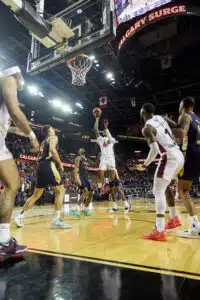
“We feel like this is a great example of the pipeline that we’re helping support because all of those qualifying matches to get to Paris, to get to the Big Dance, are born on the shoulders of CEBL players. And we couldn’t be more proud of that intersection. Then, the first people to sing those praises are th
e Canadian NBA players who know and have played against and have fostered and mentored the players that play in our league. So it’s a really interesting position to be in with all of my other counterparts in markets across this country to be growing the sport.
“One other point I’ll make in terms of the relationship and the themes that come up in the King James play … you talk about identity and you talk about friendship inherent within the story of both LeBron James, but also the people and the characters who have lived their lives experiencing this phenomenon of LeBron James and his growth. What’s been really beautiful to witness is how quickly players … who are coming from countries across the world come to Calgary [and] get acclimated so quickly in a four month season … and leave with this indelible mark of not only the city and the relationships and the stories, but also those relationships that end up lasting many, many years into the future. I’ve seen this firsthand, swinging by the condos and seeing the players playing Xbox, or seeing these moments before the guys get on the bus when they don’t know I’m watching, or my seat being close enough to the huddle that I can hear a few things. These are young men who come from all walks of life with trials, tribulations, bright spots, beauty marks and blemishes, in the same way that our city holds. To see them come together and go after a mission or a destination, have great victories or really bittersweet losses, is at the core of what makes us humans and people.
“What fans can expect in the future — the same way that you guys have captured within the performance of this play — is to give Calgarians more of a window into the long run. As the faces change, the stories change as well. If we can view some of those pieces, I think we’ll find ourselves in a very similar position to ATP of bringing these stories to the forefront and allowing Calgarians to get a window into some of these relationships. At the end of the day, they’re so enthralling and human and heartening and tear-jerking and inspiring in many ways. I could see us in the years ahead starting to do a more intentional job, or a less protective job of making sure that fans and stakeholders can get a window into those as well.”
HK: “I think sports and theatre both serve a very important piece of the community. Audiences come, and fans come shoulder to shoulder. They breathe the same story; they breathe the same game at the same time. And after the pandemic, it was really apparent how we’re an essential service in a lot of ways. And so it’s really exciting to see those numbers come back and the audiences come back, and the fans come back. What is the Surge doing to make sports, particularly your product, accessible to a large community?”
JR: “Accessibility was at the forefront of our designs from day one when we launched the team. As an entrepreneur, you’re trying to solve problems. That’s all you’re trying to do. I remember having this whiteboard in my office, and I said, ‘The ‘why’ behind bringing this team to Calgary was to make sure that neglected communities, the underdogs, had a place within these stands, and then a place within this team.’ Immediately, our minds jump to northeast Calgary. Immediately, our mind jumps to youth. Immediately, our mind jumps to all of the nonprofits and social agencies that do amazing work 365 days a year to ensure they’re a tonic in some way for some of the challenging areas of our society. How do we help them?
“Before we even put our single game tickets on sale, we designed a new program with Kids Up Front to make sure that the most vulnerable youth and the most deserving kids and families have a place at our games. Not just a ticket through the door: How do we ensure they’re included by finding themselves in the community and getting that shirt for free that says the Surge on it? How do we make sure that transportation barriers are solved? How do we make sure that food insecurities are addressed?
“We were able to work with amazing donors to help raise funds for Kids Up Front and the Surge Assist program, and before we knew it, thousands of kids have come into our arena doors through this program, including at the Saddledome, where it was the largest event in Kids Up Front history. We had over 2000 deserving kids and families in attendance. We want to ensure that, at its core, the most vulnerable are prioritized in terms of the Surge’s operations.
“The second piece is where we’ve been able to meet the market where they’re at in terms of pricing affordably and accessibly at an entry-level. And I think that’s always going to be part and parcel of what we’re doing … The concessions are affordable, and the experience is affordable compared to other offerings within the market.
“The third piece is not just the customer experience, but the game experience. And it’s subtle changes. I just created a rule that said 30 per cent of the music we play at our games will be non-English. And while that seems like a very curated, engineered thing that we’re doing, look at the charts, [like that] ROSÉ and Bruno Mars song “APT,” and the K-pop movement. Bad Bunny has four songs right now on the top 10, and Diljit Dosanjh sold out the Saddledome with 20,000 people [showing up] for a Punjabi artist. Is it really that ‘curated’ or ‘engineered,’ or is this really what people are listening to, and they’ve never had a sports experience that actually plays what they’re listening to in their cars or on their Spotify or with kids? That level of accessibility and inclusivity is that when you go to the games, the music you listen to, even if it’s not in English, will be played.
“This is just one of the examples of making sure that it’s not just an overarching, inclusive customer experience, but an accessible and inclusive game experience, or product experience as well.”
HK: “Thank you for that great response; I’m going to dovetail on that. The idea of community is the entire community, which covers all four quadrants. And I think that theatre is a very Eurocentric tradition. It’s embedded in a Eurocentric model.
“So, one of the many reasons why I programmed King James is that accessibility piece. We want to introduce a new audience to the theatre. We want to start a new tradition and a new ritual for a new community. This type of play touched upon exactly what you talked about: underrepresented communities, marginalized communities, northeast youth, and social agencies.
“We’re really excited because of the response to the show, and we’re hoping it will attract a non-traditional theatre crowd, which is what we all want. We all want to serve the entire community, not just a certain demographic of humans.”
JR: “That’s where we feel like co-conspirators and comrades in that same vein. I just thought about a show we participated in a few months ago at the Jack Singer, 360 ALLSTARS. In that previous model, there would never be (outside of Broadway) the perspective that you could have BMX bikes and a basketball net and all of these different kinds of performers in a very traditional, historic stage where the [Calgary] Philharmonic and all of these other more traditional entities play. But this is the way theatre and performance and sport and entertainment is going, and that’s to the benefit of everyone.

“From day one, we have never micro-targeted the audience. We have never gone out to the community and said, ‘We’re going to start with the basketball community.’ In fact, know that for the basketball community, [thanks to] the level of product, the fact that these guys play for us and go immediately to the NBA, or go immediately to the NBA G League, this being the highest level of basketball that has ever existed in Canada … From a league perspective, we know that we’re going to visit you where you’re at. We know that that will be there no matter what, lock, stock and barrel.
“But for everyone looking for a place to park highly discretionary income after a few challenging years after the pandemic, we need to earn that support, and we need to build that ecosystem, and you don’t slice and dice demographics to be able to get there. We’re going to go to all four corners of the city; we’re going to activate, we’re going to engage, we’re going to show up in high schools and mosques, and we’re going to make sure that we’re thoughtful enough to be invited into all of these community spaces and amplify or add value, and we’ll get to our number. And that’s been the success formula for the Surge.
“Now that we’ve found our place within this community, how do we partner and give back with organizations like ATP, [and] any other organization that finds themselves in a similar sector or line of business? Whether that’s Carifest, Expo Latino, or the Rocky Mountain Symphony Orchestra … we don’t think this is zero-sum. We say, ‘Hey, if you bought a ticket to see the Surge, here’s another opportunity to experience what’s amazing about Calgary.’ If we’re coming through [for the] community in a way that provides value, we’re running our own race … There’s more than enough to go around, and a high tide raises all boats. We feel very confident in not only competing in that environment but also building a community with that sort of sensibility.”
HK: “It’s clear that basketball and theatre have so much in common, as well as the ability to inspire, connect, and ultimately build community. So I look forward to seeing the continued growth of the Calgary Surge and how we can team up for Alberta Theatre Projects.
“Because what’s really exciting is that you’re speaking my language for getting into this business, for producing plays, for storytelling. So it’s really exciting.
“It is confirmed that sports and theatre have so much in common! There are so many parallels to attach to, and I can’t wait to partner up with the Surge and ATP on this show.”
JR: “Likewise. We’ve just scratched the surface of the collaborations we can foster and build within the arts community.
“I look back at the brand story for each season that we’ve had. The first season was titled “The First Dance,” and yes, it was a play on The Last Dance. The idea was that it’s our first season, and we’re still going to feel out what our story is. And it could be a fast dance. It could be a slow dance. Let’s see what this looks like. It’s almost an invitation.
“And then the second season, after a Championship Finals appearance, sellouts, and a lot of community impact, was titled “Encore.” We met that moment, and fans welcomed us back for a second performance.
“And now, to put a closing end on this introductory chapter of the Surge, is this idea of framing the story as a “Trilogy” and understanding that right now, we’ve really found who we are, which is at that intersection of sport and arts and entertainment.
“What fans can expect in our “Trilogy” season is even more doubling down on storytelling, that ability to foster interactivity at our games through how we use the video boards and how we do crowd engagement and deliver a season in three acts.
“The first four games [will] all have a different feel. All have a different aesthetic. And we’re so inspired by great performers, artists, and directors like you, who give us the confidence to play in that space.
“So the admiration is mutual. We’re so excited for the “Trilogy” season and to continue doubling down on our collaborations, commitments and inspiration that we garner from the arts community. I am looking forward to the work ahead.”
–
This interview has been edited for clarity and length.
